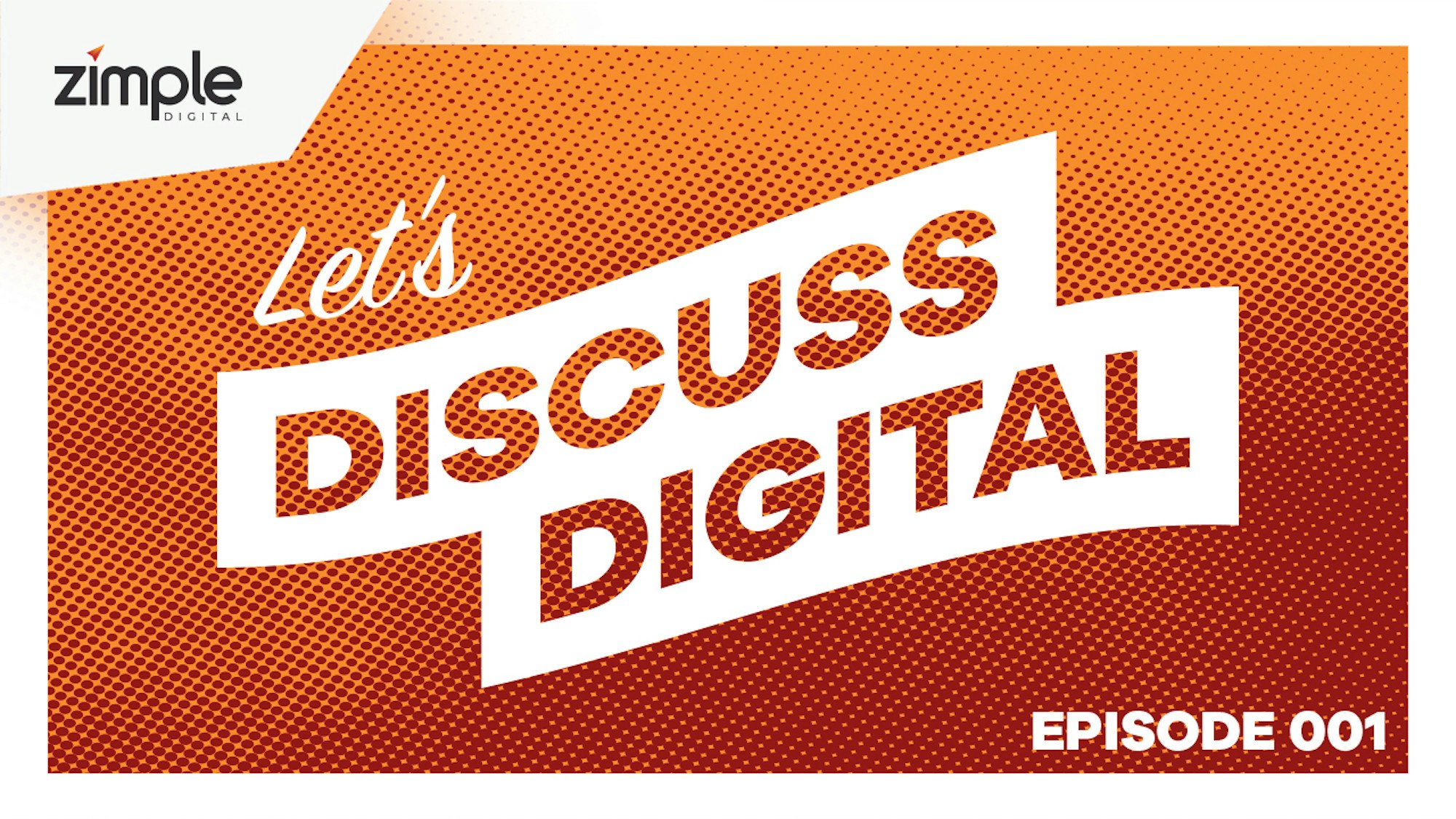Welcome to Digital Discussions!
We are rolling out a new podcast series that focuses on the nitty gritty of digital marketing. Breaking through the hype and trope we’re all becoming accustomed to. There’s nothing wrong with buzzwords, they can neatly identify trends in the industry. However, when it comes to the practical application of effective digital marketing, we need a more rounded understanding of how to make it work for our businesses. This not only ensures a greater outcome, but will also save you time and money. Sometimes, a lot of money.
Today, we’re talking ads and budgeting. One of the most common challenges businesses have is understanding the best way to utilise the set budget for their digital marketing activity. Here, we help you make the best decisions on splitting your budget for maximum efficacy.
Garth:
I’ll come at this question from a client point of view. Usually at Zimple Digital we’ve already gotten to a point with a client where we know what their budget is and we know what we’re prepared to spend on ads and campaigns. How do we then use owned data or gathered data from the client to determine where is best to spend that budget?
Glenn:
One of the beauties of online activity is the ability to track and find data. Not only on your own website but also on the market as a whole. What we do is get a good understanding of the client’s objectives and goals and, from there, start looking at the data and their digital presence in the past, and where there are opportunities to grow.
Is it a traffic challenge?
Is it an engagement challenge?
Is it a conversion challenge?
We also look for where there has been previous success with campaigns, whether that be online or offline. And really get a good understanding of what has worked and what hasn’t. We get a good understanding of the audience itself, like the demographics and psychographics. There’s a lot of insights into activities they partake in with different social platforms and it really helps to paint a picture of the type of person that is going to engage with that business, and most likely to buy something or use the service. Data plays a big part in that.
Garth:
So with that reasoning, it’s not best practice to just jam your whole budget on where 90% of what your engagement has been, so you can really focus on your KPIs and goals with that campaign, or with that budget.
Glenn:
Totally. That’s a really important question when it comes to how we decide to look at how we can maximise that budget. If we look at something that has been successful in the past, do we look at opportunities with other platforms or other activities to spread that budget or that success? Or, do we look for something completely different? If success has been with engagement, however we’re not seeing the results in conversions, what do we do there?
Do we look at how we can bring back those people? What are the questions that aren’t being answered with their online presence? And just really improving that result. Maybe the budget then is better focussed on content. If there is high engagement and a strong conversion, let’s just go and look for more of these people. It’s a traffic challenge and we try to find that quality traffic and the budget is allocated strongly in that regard.
Garth:
So I guess in terms of the client’s perspective again, how do we measure the successes (or non-success) of that campaign and make sure the budget is performing how it should?
Glenn:
Aligning with our goals and our activities that we decide would have the biggest impact and we essentially create KPIs around that. Again, the beauty of that being online and having this data that we can track the success and non-success of some of the activities we do. So back to that example of increasing traffic, if we go ahead and increase that traffic through an activity or a platform, however we’re still seeing the same result, the questions that come into play are:
Are we getting the right traffic?
Are we attracting the right people?
Is the conversation that we’re trying to initiate with them the right one?
Are we getting the right traffic but their expectations are not being met once they’ve reached their webpage or social pages?
We can look at the different metrics that we put into play and see where the successes are, and when we find the successes we grow on that again.
Garth:
On those metrics, that success could mean a whole range of different things for different clients. For some clients it might be direct sale and for some clients it can be as simple as impressions or audience growth.
Glenn:
With the range of businesses that are out there, they have their different levels of competition that comes into play, and where the market is sitting… So the activity around spend for someone that’s just interested in generating so many online form conversions a month, it’s very different from someone who just wants to introduce their business to the market place and have more of a brand awareness type of campaign.
In saying that, someone who might want to grow their leads, there definitely could be a budget allocated to that. But, how do we get more people into that mix?
We then move up the funnel and we actually look at where we’re having some success with direct marketing activity. How do we get more people that aren’t ready to make that purchase yet but are still researching and comparing businesses and services? How do we get more engagement? So we look at getting more engagement in that area. And then even beyond that, how do we get more traffic and more of the right type of audience into that funnel and move the budget that way?
One thing I always like to bring up is that whole after you have gained these clients and marketing budget with people who have already bought from you or already engaged with you? That’s another important part of this marketing mix.
Garth:
I guess another good point in terms of that budget allocation is the fact that some of that budget will go to other things and to think about including that in some of that campaign budget. Such as, video, photography, graphic design or podcast production for instance… That could also be part of that budget spend.
Glenn:
It’s always interesting when clients come onboard with us that they’ve already got a mindset that this budget is going to some kind of advertising push or servicing an SEO or content writer, that sort of thing. However, that content creation and that creativity is really important. One of the beauties of being online and the low cost of digital marketing is that you can spend a bit of time testing this content before you go for the full production work. Sp you can run some ads or social post and test certain types of imagery or certain types of content and see what resonates and gets your client, your potential client, engaging with you. You can then, after a month or two of testing, actually go ‘ok, this is what’s working. Let’s do more of this, let’s invest in more video or photography’.
To sum up , budgeting is very important to help understand what we can achieve online. It’s a great starting point. Take time to understand how your market operates online before fully investing in that.
After a month or two you should have a really good idea of where your budget should be allocated, on which platforms, and which activities. Then from there, it’s only about growing it.
Watch the video!
Welcome to Digital Discussions!
We are rolling out a new podcast series that focuses on the nitty gritty of digital marketing. Breaking through the hype and trope we’re all becoming accustomed to. There’s nothing wrong with buzzwords, they can neatly identify trends in the industry. However, when it comes to the practical application of effective digital marketing, we need a more rounded understanding of how to make it work for our businesses. This not only ensures a greater outcome, but will also save you time and money. Sometimes, a lot of money.
Today, we’re talking ads and budgeting. One of the most common challenges businesses have is understanding the best way to utilise the set budget for their digital marketing activity. Here, we help you make the best decisions on splitting your budget for maximum efficacy.
Garth:
I’ll come at this question from a client point of view. Usually at Zimple Digital we’ve already gotten to a point with a client where we know what their budget is and we know what we’re prepared to spend on ads and campaigns. How do we then use owned data or gathered data from the client to determine where is best to spend that budget?
Glenn:
One of the beauties of online activity is the ability to track and find data. Not only on your own website but also on the market as a whole. What we do is get a good understanding of the client’s objectives and goals and, from there, start looking at the data and their digital presence in the past, and where there are opportunities to grow.
Is it a traffic challenge?
Is it an engagement challenge?
Is it a conversion challenge?
We also look for where there has been previous success with campaigns, whether that be online or offline. And really get a good understanding of what has worked and what hasn’t. We get a good understanding of the audience itself, like the demographics and psychographics. There’s a lot of insights into activities they partake in with different social platforms and it really helps to paint a picture of the type of person that is going to engage with that business, and most likely to buy something or use the service. Data plays a big part in that.
Garth:
So with that reasoning, it’s not best practice to just jam your whole budget on where 90% of what your engagement has been, so you can really focus on your KPIs and goals with that campaign, or with that budget.
Glenn:
Totally. That’s a really important question when it comes to how we decide to look at how we can maximise that budget. If we look at something that has been successful in the past, do we look at opportunities with other platforms or other activities to spread that budget or that success? Or, do we look for something completely different? If success has been with engagement, however we’re not seeing the results in conversions, what do we do there?
Do we look at how we can bring back those people? What are the questions that aren’t being answered with their online presence? And just really improving that result. Maybe the budget then is better focussed on content. If there is high engagement and a strong conversion, let’s just go and look for more of these people. It’s a traffic challenge and we try to find that quality traffic and the budget is allocated strongly in that regard.
Garth:
So I guess in terms of the client’s perspective again, how do we measure the successes (or non-success) of that campaign and make sure the budget is performing how it should?
Glenn:
Aligning with our goals and our activities that we decide would have the biggest impact and we essentially create KPIs around that. Again, the beauty of that being online and having this data that we can track the success and non-success of some of the activities we do. So back to that example of increasing traffic, if we go ahead and increase that traffic through an activity or a platform, however we’re still seeing the same result, the questions that come into play are:
Are we getting the right traffic?
Are we attracting the right people?
Is the conversation that we’re trying to initiate with them the right one?
Are we getting the right traffic but their expectations are not being met once they’ve reached their webpage or social pages?
We can look at the different metrics that we put into play and see where the successes are, and when we find the successes we grow on that again.
Garth:
On those metrics, that success could mean a whole range of different things for different clients. For some clients it might be direct sale and for some clients it can be as simple as impressions or audience growth.
Glenn:
With the range of businesses that are out there, they have their different levels of competition that comes into play, and where the market is sitting… So the activity around spend for someone that’s just interested in generating so many online form conversions a month, it’s very different from someone who just wants to introduce their business to the market place and have more of a brand awareness type of campaign.
In saying that, someone who might want to grow their leads, there definitely could be a budget allocated to that. But, how do we get more people into that mix?
We then move up the funnel and we actually look at where we’re having some success with direct marketing activity. How do we get more people that aren’t ready to make that purchase yet but are still researching and comparing businesses and services? How do we get more engagement? So we look at getting more engagement in that area. And then even beyond that, how do we get more traffic and more of the right type of audience into that funnel and move the budget that way?
One thing I always like to bring up is that whole after you have gained these clients and marketing budget with people who have already bought from you or already engaged with you? That’s another important part of this marketing mix.
Garth:
I guess another good point in terms of that budget allocation is the fact that some of that budget will go to other things and to think about including that in some of that campaign budget. Such as, video, photography, graphic design or podcast production for instance… That could also be part of that budget spend.
Glenn:
It’s always interesting when clients come onboard with us that they’ve already got a mindset that this budget is going to some kind of advertising push or servicing an SEO or content writer, that sort of thing. However, that content creation and that creativity is really important. One of the beauties of being online and the low cost of digital marketing is that you can spend a bit of time testing this content before you go for the full production work. Sp you can run some ads or social post and test certain types of imagery or certain types of content and see what resonates and gets your client, your potential client, engaging with you. You can then, after a month or two of testing, actually go ‘ok, this is what’s working. Let’s do more of this, let’s invest in more video or photography’.
To sum up , budgeting is very important to help understand what we can achieve online. It’s a great starting point. Take time to understand how your market operates online before fully investing in that.
After a month or two you should have a really good idea of where your budget should be allocated, on which platforms, and which activities. Then from there, it’s only about growing it.
Watch the video!






